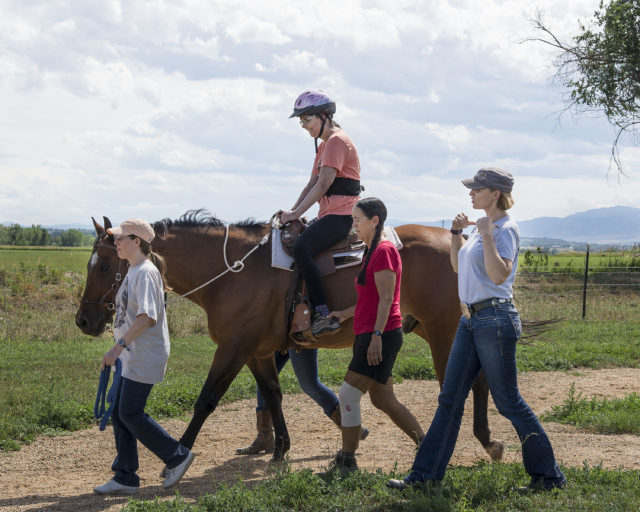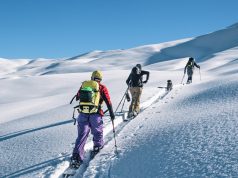
A few years ago, Jennifer Pyjas slipped into a coma after an unsuccessful bone marrow transplant.
It took a year in the hospital, but Pyjas recovered and eventually moved from South Carolina to Colorado, partly because her cousin, Robyn Morgan, a long-time volunteer at the Colorado Therapeutic Riding Center (CTRC) in Longmont, knew Pyjas would be a perfect candidate for therapeutic horseback riding.
Pyjas uses a wheelchair during her day-to-day life, but that’s not an obstacle to riding. When she first started at CTRC, Pyjas used a custom saddle — what barn manager Lindsey Moloznik calls adaptive tack, with a t-bar support where the horn of a Western saddle would be — to help her balance and stay on the horse. She also started by using reins with handles to aid her grip.

This year, Pyjas won the Adult Rider of the Year Award at CTRC and can trot across the ring holding onto standard reins, supported by her volunteer team that includes a leader and her cousin as one of her two side walkers.
Since 1980, CTRC has offered a therapeutic riding program for adults and children with a range of disabilities, including Multiple Sclerosis, traumatic brain injury, stroke, developmental delays, autism and visual impairment. In 1982, CTRC received accreditation from the Professional Association of Therapeutic Horsemanship (PATH) International; each CTRC instructor goes through PATH training for a certificate.
The program rotates throughout the year with four sessions varying in length, between six and 13 weeks. Therapeutic riding is taught in groups of two to four, while hippotherapy, which is similar to therapeutic riding, is taught one-on-one with a rider and a certified therapist.
Program director Heather McLaughlin explains that the benefits of therapeutic riding go beyond building physical strength and balance. According to McLaughlin, everyone is a rider first, “participating in an equestrian sport as an equestrian, pursuing equestrian goals. It’s just that they’re meeting all these physical goals in this case as well.”

“The physical strength and endurance and confidence to get up in a two-point position, and the balance, the bilateral coordination that that takes, is incredible,” she explains. “The rider often has no idea that they’re bringing all of those facets to the move, but a physical therapist knows it.”
McLaughlin also says that it can help as a motivator for people working on their speech. In an office setting there can be less motivation for speech than in a riding ring, where saying “walk on” or “woah” results in instant feedback as the horse responds to the command.
The benefits are more than anecdotal. Children’s Hospital teamed with CTRC a few years ago to conduct a yearlong study of the effects of therapeutic riding on children with autism and overwhelmingly found positive results on hyperactivity, expressive language and motor coordination, among other characteristics of autism.
CTRC has 25-plus horses, all of which can meet different needs for different riders.
Head instructor Michelle Bruhn says that from the minute a rider walks in the door, she is thinking about what kind of horse and saddle might be best for them.
According to Moloznik and Bruhn, there are a number of variables to factor in when choosing the right horse for a rider, including horse size and shape, their gait, as well as the rider’s diagnosis, size, ability and what they will benefit most from in a horse. For instance, a child with attention deficit disorder may benefit most from a horse with high motion.
The tack — or saddle and reins — is also a consideration. Adaptive tack is created for riders who have different limitations, such as Pyjas’ t-bar saddle or reins adapted to work with someone who might only have the use of one side of their body.
Students at CTRC get more than just therapy while they’re in the ring. Family-like relationships form between riders, volunteers and staff members, such as the bond between the four female riders of the Happy Bottoms Riding Club.
One of these women, Pat Hatfield, who has a neurodegenerative disease called ALS, has been at CTRC for around five years after a member of her support group turned her on to the idea. She’s enjoyed riding so much that when the first horse she rode, Corky, was retired, she pitched in with a few volunteers to pay for his adoption fee.

Hatfield says her favorite thing is, “the family of CTRC, the community of the staff and the volunteers, the instructors, the horses. They make everything so safe and they challenge you without putting you at any risk.”
Annette Gruba has been working with CTRC as one of the therapeutic riding instructors for 11 years, and has been working with therapeutic riding for 17 years. Gruba works with Pyjas, Hatfield and the rest of the riders in the Happy Bottoms Riding Club.
For Gruba, lesson planning is key to ensuring that riders can be successful. In certain cases, riders may not be able to hold things in both hands, or use their legs to cue the horse.
“The volunteers are a great resource for us,” Gruba says. “They help in the adaptive sense as much as the equipment does a lot of times.”
Cognitive ability is something Gruba takes heavily into consideration while planning lessons. For some groups, walking along CTRC’s sensory trail while being quizzed on the names of shapes and colors may be the perfect lesson plan. For other groups, that kind of lesson wouldn’t fit.
“The physical ability, frankly, I take into consideration less, because if they can sit up on a horse, if they can hold themselves up basically, we can work on all kinds of skills,” Gruba says.
For Pyjas, what she says she likes the most about CTRC is “the independence of it” and she says that despite the nerves that may come along with riding, she is sure that if she were to fall, her volunteers would be there to catch her.














